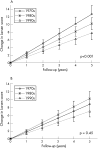Progression of radiographic joint damage in different eras: trends towards milder disease in rheumatoid arthritis are attributable to improved treatment
- PMID: 16540549
- PMCID: PMC1798270
- DOI: 10.1136/ard.2005.049338
Progression of radiographic joint damage in different eras: trends towards milder disease in rheumatoid arthritis are attributable to improved treatment
Abstract
Background: Severity of rheumatoid arthritis and progression of radiographic joint damage have decreased over the last decades.
Aim: To examine whether this trend is attributable to an underlying trend towards milder disease or to improved treatment.
Methods: The study used an inception cohort of patients with early rheumatoid arthritis seen at the Wichita Arthritis Center, Wichita, Kansas, USA, since 1973 and monitored prospectively since their first clinic visit through clinical, radiographic, laboratory, demographic and self-reported data. The radiographic disease progression in patients with disease onset in the 1970s, 1980s and 1990s was compared using a multivariate regression model for longitudinal data. The analysis was adjusted for differences in baseline predictors, type of disease-modifying antirheumatic drugs (DMARDs) and steroid use.
Results: 418 patients with rheumatoid arthritis with radiographic follow-up were included. Patients in earlier decades used fewer DMARDs, had longer disease durations and higher tender joint counts at their first visit. Other important predictors of disease progression did not differ significantly between decades of disease onset. The unadjusted rates of radiographic progression differed between decades (analysis of variance, p = 0.01), with a significant trend towards less radiographic progression in more recent times (trend, p<0.001). However, after adjusting for DMARD use, steroid use and baseline predictors, differences between decades vanished (analysis of variance, p = 0.40) and the trend towards less radiographic progression disappeared (trend, p = 0.45).
Conclusion: These results suggest that the observed trend towards milder disease in rheumatoid arthritis is attributable to more effective antirheumatic treatment and not to a secular trend.
Conflict of interest statement
Competing interests: None declared.
References
-
- Silman A J. Trends in the incidence and severity of rheumatoid arthritis. J Rheumatol Suppl 19923271–73. - PubMed
-
- Silman A J. Are there secular trends in the occurrence and severity of rheumatoid arthritis? Scand J Rheumatol Suppl 19897925–30. - PubMed
-
- Aho K, Tuomi T, Palosuo T, Kaarela K, Von Essen R, Isomaki H. Is seropositive rheumatoid arthritis becoming less severe? Clin Exp Rheumatol 19897287–290. - PubMed
-
- Doran M F, Pond G R, Crowson C S, O'Fallon W M, Gabriel S E. Trends in incidence and mortality in rheumatoid arthritis in Rochester, Minnesota, over a forty‐year period. Arthritis Rheum 200246625–631. - PubMed
Publication types
MeSH terms
Substances
LinkOut - more resources
Full Text Sources
Medical



